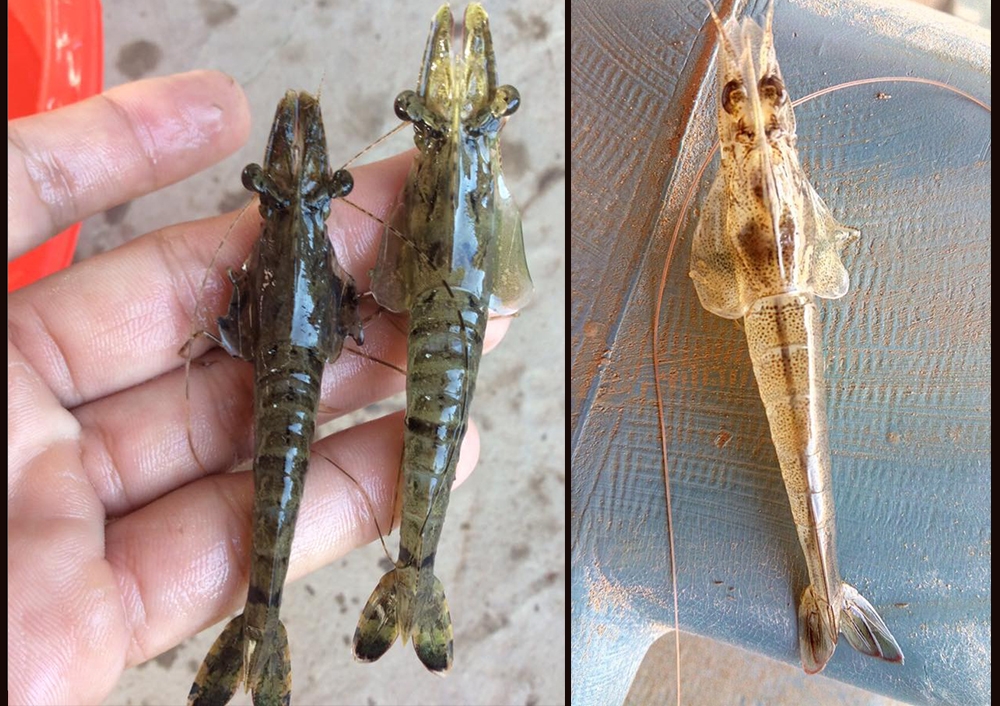
Recently, many shrimp ponds in Tra Vinh province appeared the phenomenon of black tiger shrimp suffering from a strange disease, temporarily called gill gill disease.
In the midst of confusion, many shrimp farmers suspected that the disease was caused by shrimp feed. Is that true?
According to Dr. Nguyen Ngoc Phuoc (Faculty of Fisheries, Hue University of Agriculture and Forestry), this is a new disease appearing on shrimp in Vietnam, but in the world, there have been recorded documents about this disease. Due to the lack of conditions to come to Tra Vinh to examine the reality and take samples for testing, Dr. Phuoc could not confirm what the cause of the disease on black tiger shrimp in Tra Vinh was. But he said that the disease in shrimp has many causes. Therefore, do not rush to confirm the cause of the disease
As mentioned above, because this is a very new disease in shrimp in Vietnam, there are no documents and studies related to this disease. Through the help of a number of aquatic disease scientists, we have found a number of foreign documents on a shrimp disease with similar manifestations.
This is a Vibrio disease, which is a serious system of diseases caused by bacteria, according to the Agricultural Research Council of India. These pathogens are Vibrio alginolitucus, Vibrio anguillarum and Vibrio parahaemolyticus. Infected shrimp have symptoms of lethargy, lethargy, and abnormal swimming. Swimmers and flippers may appear red spots due to hyperpigmentation, the ventral vertebrae may be slightly deformed. In case of severe infection of shrimp, the gill cover of shrimp will be raised and corroded. In more severe cases, black spots can be seen on the shrimp’s head and belly shells. The disease appeared in both white shrimp and black tiger shrimp.

On May 1, 2017, the Department of Aquatic Pathology (Faculty of Fisheries, University of Agriculture and Forestry, Ho Chi Minh City), took samples in some ponds with the phenomenon of black tiger shrimp with Soldiers cap disorder in Cau Ngang district, Tra Vinh. In these ponds, black tiger shrimp showed disease symptoms, including: slightly soft shell, light seaweed; gill cover sheath peeled off and flaked, worn black pigment; dirty gills; Some shrimp have rough shells like bamboo roots.
Comparing the survey of the Department of Aquatic Pathology with the documents of the Agricultural Research Council of India, the black tiger shrimp with gills in Tra Vinh had similar symptoms to the bacterial infection caused by Vibrio in India.
In the samples of pond water, pond bottom sludge, shrimp liver and shrimp intestines collected by the Department of Aquatic Pathology, the test results (bacteria isolated on Chromagar Vibrio medium) showed a very high concentration of bacteria. , especially with two bacteria Vibrio alginolyticus and Vibrio vulnificus/Vibrio cholerae.
In 1 pond, Vibrio alginolyticus had a density of 60 cfu/ml in pond water, 400 cfu/ml in pond bottom sludge, 250 cfu/ml in liver (shrimp 1), 840 cfu/ml in gut (shrimp 1), 0 cfu/ml in liver (shrimp 2), 5,040 cfu/ml in gut (shrimp 2), 120 cfu/ml in liver (shrimp 3), 21,120 cfu/ml in gut (shrimp 3), 380 cfu/ml in liver (shrimp 3) shrimp 4), 8,200 cfu/ml in gut (shrimp 4), 0 cfu/ml in liver (shrimp 5) and 15,160 cfu/ml in gut (shrimp 5); Vibrio vulnificus/Vibrio cholerae had a density of 490 cfu/ml in pond water, 1,440 cfu/ml in pond bottom sludge, 160 cfu/ml in liver (shrimp 1), 1,000 cfu/ml in gut (shrimp 1), 0 cfu /ml in liver (shrimp 2), 3,600 cfu/ml in gut (shrimp 2), 0 cfu/ml in liver (shrimp 3), 1,520 cfu/ml in gut (shrimp 3), 50 cfu/ml in liver (shrimp). 4), 0 cfu/ml in gut (shrimp 4), 0 cfu/ml in liver (shrimp 5) and 1,400 cfu/ml in gut (shrimp 5)
In another pond, Vibrio alginolyticus had a density of 120 cfu/ml in pond water, 520 cfu/ml in pond bottom sludge, 1,300 cfu/ml in liver (shrimp 1), 1,280 cfu/ml in gut (shrimp 1), 320 cfu/ml in liver (shrimp 2), 880 cfu/ml in gut (shrimp 2), 570 cfu/ml in liver (shrimp 3), 250 cfu/ml in gut (shrimp 3), 40 cfu/ml in liver (shrimp 4), 120 cfu/ml in gut (shrimp 4), 400 cfu/ml in liver (shrimp 5) and 1600 cfu/ml in gut (shrimp 5); Vibrio vulnificus/Vibrio cholerae had a density of 1,130 cfu/ml in pond water, 2,240 cfu/ml in pond bottom sludge, 480 cfu/ml in liver (shrimp 1), 5,920 cfu/ml in gut (shrimp 1), 190 cfu /ml in liver (shrimp 2), 5,880 cfu/ml in gut (shrimp 2), 490 cfu/ml in liver (shrimp 3), 90 cfu/ml in gut (shrimp 3), 520 cfu/ml in liver (shrimp). 4), 760 cfu/ml in gut (shrimp 4), 580 cfu/ml in liver (shrimp 5) and 9,760 cfu/ml in gut (shrimp 5).
Thus, the results of bacteriological examination of the Department of Aquatic Pathology showed that Vibrio alginolyticus and Vibrio vulnificus/Vibrio cholerae were present in high concentrations in water, sludge, liver and shrimp samples. In which, Vibrio alginolyticus has been confirmed by the Agricultural Research Council of India to be the causative agent of Vibrio infections with symptoms similar to the disease that has just appeared in Tra Vinh.
While waiting for authorities, institutes, schools and scientists to clarify the cause of gill disease in shrimp, farmers need to actively take measures to prevent and treat the disease. According to the Agricultural Research Council of India document, the preventive measure for Vibrio infections is to maintain good water quality and reduce organic matter through increased water exchange in ponds.
Treatment measures are to increase water exchange with clean and salty water; feed shrimp with antibiotic-containing food (the pathogen’s susceptibility has been determined by antibiotic susceptibility testing). For example: feeding feed containing Oxytetracycline with a concentration of 1.5g/kg, feeding rate of 2 – 10% of shrimp weight within 10-14 days, combined with reasonable pond water management. Note that a pre-harvest quarantine period (25-30 days) is required to inactivate and neutralize the harmful effects of antibiotics.

 Tiếng Việt
Tiếng Việt Indonesia
Indonesia